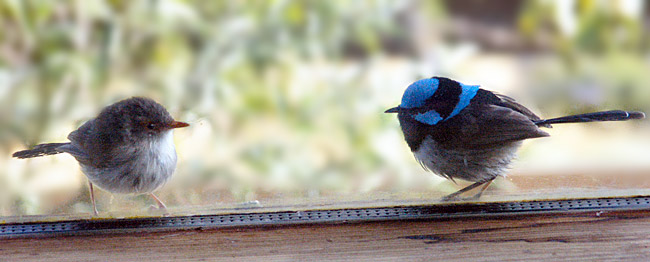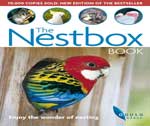
A Bird in the Bush...
Robyn Diamond
The Sydney Morning Herald recently published an article about the influence that plant types are having on bird populations in Sydney gardens.
According to Associate Professor Burgin from the University of Western Sydney, the growing obsession of Sydneysiders with grevilleas had turned lorikeets into urban "invaders". The newer plant hybrids - cultivated to produce spectacular floral displays that would never occur naturally - had turned Sydney gardens into honey pots.
Professor Burgin was not blaming gardeners for the lorikeet population boom - but was asking gardeners to be aware of how their plant choices affect wildlife.
 |
| Up close and personal; Friends on a windowsill (Photo: Dick Diamond) |
Hints for planting
We all love to see our gardens bloom, but what can we do when we plan and plant our gardens that will provide shelter and food for a wide range of birds? The Canberra Ornithologists Group (COG) recommends that bird-lovers:
| |
| The Nest Box Book |

This practical and informative book guides you through the process of selecting, constructing, installing and maintaining a selection of nestboxes for a variety of native Australian birds and mammals. A new addition is expected in late April.
For further information visit the Gould Group's web site.
|
|
- Create a mixture of over-storey, middle-storey and under-storey using trees, large shrubs, small shrubs, wildflowers and grasses. This combination will attract native birds which feed on nectar, insects, fruit and seeds. Dense and prickly shrubs can also be planted to provide protection from predators at ground level. Try to plant some species which flower in winter when food is scarce. Birds are attracted to plantings which create small dense patches of green interfacing with open sunlight.
- Provide water for birds - water features may be as important in attracting birds as native plants. If possible water depths varying from 3 to 8 cm should be used. Bird baths must be out of reach of cats (at least 1.7 m above the ground) and preferably under a shaded branch or perch where birds can enter and leave safely. Bird baths need regular refilling and cleaning.
- Build a small platform high in the garden in early spring to offer nesting materials, such as human or animal hair, small lengths of wool, dry soft grass, teased out cotton wool and clean carpet fluff or underfelt.
- Avoid exotic plants such as cotoneaster, firethorn, privet, crab apple, rowan, ornamental plum and hawthorn. Pied Currawongs now have large permanent urban populations in Canberra, which feed predominantly on exotic berries during colder months, spreading the seeds into natural areas. During the breeding season these same flocks predate heavily on many species of small birds and their nestlings.
- Avoid feeding native birds, as it may lead to a long term decrease in numbers through increased dependence on artificial food, obesity, nutritional deficiencies and ultimately reproduction failures. Choose the right plants instead.
COG's website is a valuable source of information and has some great photos of Canberra region birds. The website says that most species and hybrids of Acacia, Banksia, Callistomen, Calothamnus, Casuarina, Epacris, Eucalyptus, Grevillea, Hakea, Hibbertia, Leptospermum and Melaleuca attract native birds. It suggests a range of plant species that provide nectar, insects, fruit and seed and shelter for birds. One member also suggested that the forms of Eremophila suitable for Canberra are also good bird attractors .
Nesting
Many birds nest in hollows in trees. You can use suitably constructed nest boxes to attract these birds to your garden.
The Nest-Box Book, published by the Gould Group, describes how to build and maintain nest boxes for a wide range of birds. It is important that nest boxes are carefully monitored and maintained. There is always a large risk that mynas and starlings will drive native birds away from nest boxes, and even build their own nest over the eggs or young of the original occupants. The Nest Box Book explains how to build a nest box that is claimed to be starling- and myna-proof. Adding a baffle is thought to prevent the starlings or mynas flying directly into the hole. Apparently, these birds prefer to fly directly into the hole, whereas many native birds and mammals prefer to climb into nest boxes.
Cats and Dogs
A free-roaming cat is not compatible with wild birds. A purpose-built back yard cat run allows room for cats to exercise, while protecting native birds in the rest of the garden.
While dogs have the potential to do some damage to native wildlife visiting a garden, they are generally not the instinctive inveterate hunters that cats are. Even if you don't have a free-roaming cat, there are almost certainly such cats in the neighbourhood. Any yard is likely to be taken over as part of the territory of at least one of these cats. One way to prevent this is to have a dog.
Websites
From the newsletter of the Australian Native Plants Society (Canberra), December 2007.
Australian Plants online - 2008
Association of Societies for Growing Australian Plants
|